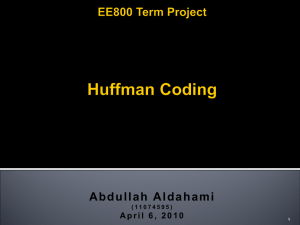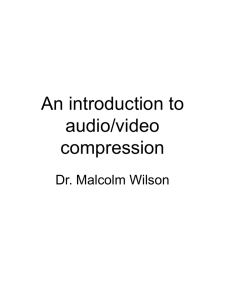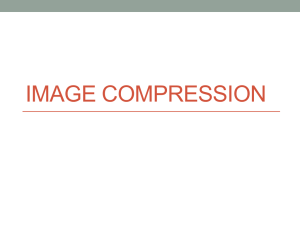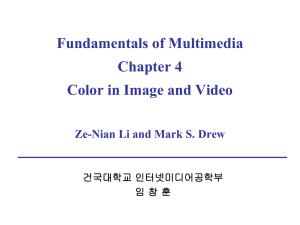Chapter 7. Lossless compression algorithms
advertisement
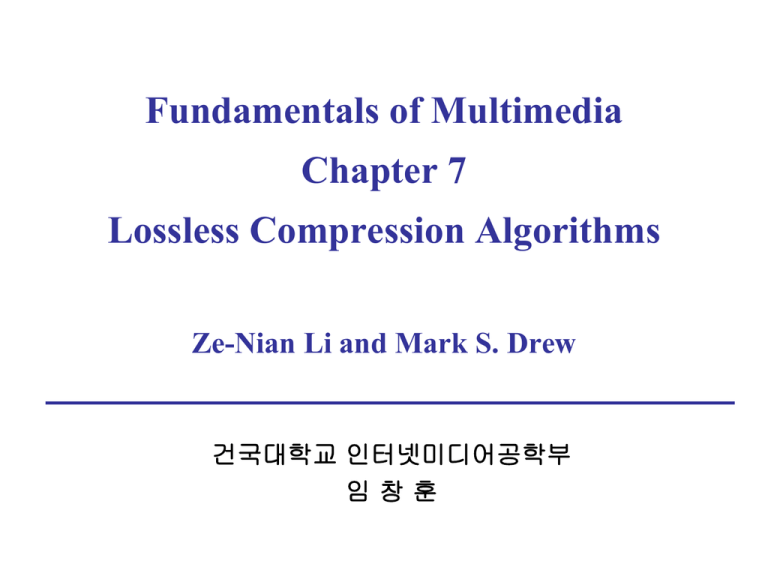
Fundamentals of Multimedia
Chapter 7
Lossless Compression Algorithms
Ze-Nian Li and Mark S. Drew
건국대학교 인터넷미디어공학부
임창훈
Outline
7.1 Introduction
7.2 Basics of Information Theory
7.3 Run-length Coding
7.4 Variable-length Coding
7.4.1 Shannon-Fano Algorithm
7.4.2 Huffman Coding
7.6 Arithmetic Coding
Chap 7 Lossless Compression Algorithms
Li & Drew; 인터넷미디어공학부 임창훈
2
2.1 Introduction
Compression: the process of coding that will
effectively reduce the total number of bits
needed to represent certain information.
General data compression scheme
Chap 7 Lossless Compression Algorithms
Li & Drew; 인터넷미디어공학부 임창훈
3
If the compression and decompression processes
induce no information loss, then the compression
scheme is lossless;
otherwise, it is lossy.
Compression ratio:
compression ratio =B0 / B1
B0 : number of bits before compression
B1 : number of bits after compression
Chap 7 Lossless Compression Algorithms
Li & Drew; 인터넷미디어공학부 임창훈
4
7.2 Basics of Information Theory
The entropy of an information source with alphabet
S = {s1, s2, …, sn}
pi : probability that symbol si will occur in S.
log2(1/pi) : the amount of information contained in si,
which corresponds to the number of bits
needed to encode si.
Chap 7 Lossless Compression Algorithms
Li & Drew; 인터넷미디어공학부 임창훈
5
Distribution of Gray-Level Intensities
Fig. 7.2 Histograms for two gray-level images.
Fig. 7.2(a) shows the histogram of an image with
uniform distribution of gray-level intensities, i.e.,
pi = 1/256 for all i.
Hence, the entropy of this image is:
log2 256 = 8
Chap 7 Lossless Compression Algorithms
Li & Drew; 인터넷미디어공학부 임창훈
6
Entropy and Code Length
The entropy H(S) is a weighted-sum of terms log2(1/pi)
Hence it represents the average amount of information
contained per symbol in the source S.
The entropy H(S) specifies the lower bound for the
average number of bits to code each symbol in S, i.e.,
H (S ) £ l
l
- the average length (in bits) of the codewords
produced by the encoder
Chap 7 Lossless Compression Algorithms
Li & Drew; 인터넷미디어공학부 임창훈
7
7.3 Run-Length Coding
Memoryless Source: an information source that is
independently distributed. Namely, the value of the
current symbol does not depend on the values of the
previously appeared symbols.
Instead of assuming memoryless source,
Run-Length Coding (RLC) exploits memory present
in the information source.
Chap 7 Lossless Compression Algorithms
Li & Drew; 인터넷미디어공학부 임창훈
8
7.4 Variable-Length Coding (VLC)
Shannon-Fano Algorithm : a top-down approach
1. Sort the symbols according to the frequency count
(probability) of their occurrences.
2. Recursively divide the symbols into two parts, each with
approximately the same number of counts, until all parts
contain only one symbol.
An Example: coding of “HELLO“
Frequency count of the symbols in "HELLO".
Chap 7 Lossless Compression Algorithms
Li & Drew; 인터넷미디어공학부 임창훈
9
Shannon-Fano Algorithm
Coding tree for HELLO by the Shannon-Fano algorithm
Chap 7 Lossless Compression Algorithms
Li & Drew; 인터넷미디어공학부 임창훈
10
Shannon-Fano Algorithm
One result of performing the Shannon-Fano algorithm on HELLO
Chap 7 Lossless Compression Algorithms
Li & Drew; 인터넷미디어공학부 임창훈
11
Shannon-Fano Algorithm
Another coding tree for HELLO by the Shannon-Fano algorithm
Chap 7 Lossless Compression Algorithms
Li & Drew; 인터넷미디어공학부 임창훈
12
Shannon-Fano Algorithm
Another result of performing the Shannon-Fano algorithm on HELLO
Chap 7 Lossless Compression Algorithms
Li & Drew; 인터넷미디어공학부 임창훈
13
7.4.2 Huffman Coding
Huffman coding Algorithm : a bottom-up approach
1. Initialization: Put all symbols on a list sorted according
to their frequency counts (probability).
2. Repeat until the list has only one symbol left:
(a) From the list pick two symbols with the lowest frequency
counts (probability). Form a Huffman subtree that has
these two symbols as child nodes and create a parent node.
(b) Assign the sum of the children's frequency counts to
the parent and insert it into the list such that the order
is maintained.
(c) Delete the children from the list.
3. Assign a codeword for each leaf based on the path from
the root.
Chap 7 Lossless Compression Algorithms
Li & Drew; 인터넷미디어공학부 임창훈
14
Huffman Coding
Coding tree for HELLO by the Huffman algorithm
Chap 7 Lossless Compression Algorithms
Li & Drew; 인터넷미디어공학부 임창훈
15
Huffman Coding
New symbols P1, P2, P3 are created to refer to the
parent nodes in the Huffman coding tree.
The contents in the list are illustrated below:
Chap 7 Lossless Compression Algorithms
Li & Drew; 인터넷미디어공학부 임창훈
16
Properties of Huffman Coding
1. Unique Prefix Property: No Huffman code is a prefix
of any other Huffman code
- precludes any ambiguity in decoding.
Chap 7 Lossless Compression Algorithms
Li & Drew; 인터넷미디어공학부 임창훈
17
2. Optimality: minimum redundancy code –
proved optimal for a given data model
(i.e., a given probability distribution):
• The two least frequent symbols will have the same
length for their Huffman codes, differing only at the
last bit.
• Symbols that occur more frequently (higher probability)
will have shorter Huffman codes than symbols that
occur less frequently.
• The average code length for an information source S
is strictly less than η + 1.
Chap 7 Lossless Compression Algorithms
Li & Drew; 인터넷미디어공학부 임창훈
18
7.6 Arithmetic Coding
Arithmetic coding is a more modern coding method
that usually out-performs Huffman coding.
Huffman coding assigns each symbol a codeword which
has an integral bit length. Arithmetic coding can treat
the whole message as one unit.
A message is represented by a half-open interval
[a. b)
where a and b are real numbers between 0 and 1.
Chap 7 Lossless Compression Algorithms
Li & Drew; 인터넷미디어공학부 임창훈
19
Initially, the interval is [0, 1).
When the message becomes longer, the length of the
interval shortens and the number of bits needed
to represent the interval increases.
Chap 7 Lossless Compression Algorithms
Li & Drew; 인터넷미디어공학부 임창훈
20
Arithmetic Coding
Arithmetic coding encoder
Chap 7 Lossless Compression Algorithms
Li & Drew; 인터넷미디어공학부 임창훈
21
Example: Encoding in Arithmetic Coding
Arithmetic Coding: Encode Symbols CAEE$
(a) Probability distribution of symbols.
Chap 7 Lossless Compression Algorithms
Li & Drew; 인터넷미디어공학부 임창훈
22
(b) Graphical display of shrinking ranges
Chap 7 Lossless Compression Algorithms
Li & Drew; 인터넷미디어공학부 임창훈
23
(c) New low, high, and range generated.
Chap 7 Lossless Compression Algorithms
Li & Drew; 인터넷미디어공학부 임창훈
24
Generating codeword for encoder
The final step in Arithmetic encoding calls for the
generation of a number that falls within the range
[low; high). The above algorithm will ensure that the
shortest binary codeword is found.
Chap 7 Lossless Compression Algorithms
Li & Drew; 인터넷미디어공학부 임창훈
25
Arithmetic coding decoder
Chap 7 Lossless Compression Algorithms
Li & Drew; 인터넷미디어공학부 임창훈
26
Arithmetic coding: decode symbols CAEE$
Chap 7 Lossless Compression Algorithms
Li & Drew; 인터넷미디어공학부 임창훈
27
7.7 Lossless Image Compression
Approaches of Differential Coding of Images:
Given an original image I(x, y), using a simple
difference operator we can define a difference image
d(x, y) as follows:
d(x, y) = I(x, y) − I(x − 1, y)
or use the discrete version of the 2-D Laplacian
operator to define a difference image d(x, y) as
d(x, y) = 4I(x, y) − I(x, y − 1) − I(x, y +1) −
I(x+1, y) − I(x−1, y)
Due to spatial redundancy existed in normal images I,
the difference image d will have a narrower histogram
and hence a smaller entropy.
Chap 7 Lossless Compression Algorithms
Li & Drew; 인터넷미디어공학부 임창훈
28
Distributions for Original versus Derivative Images. (a): Original
gray-level image (b) Partial derivative image; (c): Histograms for original
(d) Histogram for derivative images.
Chap 7 Lossless Compression Algorithms
Li & Drew; 인터넷미디어공학부 임창훈
29
Lossless JPEG
Lossless JPEG: A special case of the JPEG image
compression.
The Predictive method
1. Forming a differential prediction:
A predictor combines the values of up to three
neighboring pixels as the predicted value for the
current pixel, indicated by `X' in Fig. 7.10.
2. Encoding: The encoder compares the prediction with
the actual pixel value at the position `X' and encodes
the difference using one of the lossless compression
techniques we have discussed, e.g., the Huffman coding
scheme.
Chap 7 Lossless Compression Algorithms
Li & Drew; 인터넷미디어공학부 임창훈
30
Fig. 7.10: Neighboring Pixels for Predictors in Lossless JPEG.
Note: Any of A, B, or C has already been decoded before it
is used in the predictor, on the decoder side of an encodedecode cycle.
Chap 7 Lossless Compression Algorithms
Li & Drew; 인터넷미디어공학부 임창훈
31
Predictors for Lossless JPEG
Chap 7 Lossless Compression Algorithms
Li & Drew; 인터넷미디어공학부 임창훈
32

